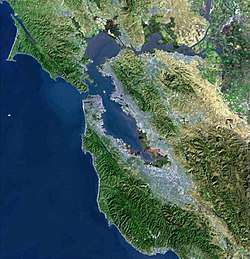San Carlos, California
San Carlos is a city in San Mateo County, California, United States. The population is 28,406 per the 2010 census.
San Carlos, California | |
|---|---|
City | |
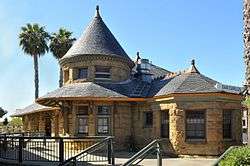 San Carlos Train Station | |
 Seal | |
| Motto(s): "City Of Good Living" | |
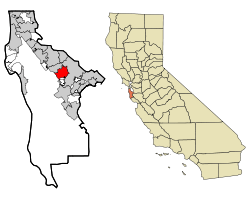 Location in San Mateo County and the state of California | |
 San Carlos, California Location in the contiguous United States of America | |
| Coordinates: 37°29′44″N 122°16′00″W[1] | |
| Country | |
| State | |
| County | San Mateo |
| Incorporated | July 8, 1925[2] |
| Government | |
| • Type | Council–manager[3] |
| • City council[4] | Mark Olbert, Mayor Ron Collins, Vice Mayor Sara McDowell Laura Parmer-Lohan Adam Rak |
| • City treasurer | Michael Galvin[5] |
| • City manager | Jeff Maltbie[3] |
| • State senator | Jerry Hill (D)[6] |
| • Assemblymember | Kevin Mullin (D)[6] |
| Area | |
| • Total | 5.41 sq mi (14.02 km2) |
| • Land | 5.41 sq mi (14.02 km2) |
| • Water | 0.00 sq mi (0.00 km2) 0.05% |
| Elevation | 33 ft (10 m) |
| Population | |
| • Total | 28,406 |
| • Estimate (2019)[10] | 30,185 |
| • Density | 5,578.45/sq mi (2,153.76/km2) |
| Time zone | UTC−8 (Pacific) |
| • Summer (DST) | UTC−7 (PDT) |
| ZIP codes | 94070, 94071 |
| Area code | 650 |
| FIPS code | 06-65070 |
| GNIS feature IDs | 277592, 2411780 |
| Website | www |
History
Native Americans
Prior to the Spanish arrival in 1769, the land of San Carlos was occupied by a group of Native Americans who called themselves the Lamchins.[11] While they considered themselves to have a separate identity from other local tribes, modern scholars consider them to be a part of the Ohlone or Costanoan tribes that inhabited the Bay Area.
The Lamchins referred to the area of their primary residence—probably on the north bank of Pulgas creek—as "Cachanihtac", which included their word for vermin. When the Spanish arrived, they translated this as "the fleas", or "las Pulgas", giving many places and roads their modern names.
The Native American life was one of traditional hunting and gathering. There was plentiful game and fowl available, and fish could be caught in the San Francisco Bay. There were also grasses, plants and oak trees (for acorns), and archaeological finds of mortars and pestles indicate that these source were processed for food. No doubt they also participated in the regional trading networks for goods that could not be gathered or grown locally.
The Lamchin permanent village is thought to have been between the modern streets of Alameda de las Pulgas and Cordilleras Avenue, near San Carlos Avenue.
Spanish colonial era
In 1769, Gaspar de Portolá was the first westerner to reach the San Francisco Bay. While early historians placed his approach to the Bay from the Pacific Ocean as coming over the San Carlos hills, present researchers believe this "discovery" actually occurred in present-day Belmont.
The Spanish, with overwhelming military and economic advantages over the native population, quickly dominated the Bay Area. A mission was established in San Francisco, and land was deeded in large "ranchos", or ranches, to prominent and wealthy Spaniards, with no concern for the native populations that lived on them.
The new ranch owners raised cattle on the lands, displacing the native game populations and disrupting the food supply of the indigenous population. As well, the Spanish strongly discouraged the Native Americans from their periodic controlled burns, which helped maintain the grasslands.
Facing the end of their way of life, the local population had little choice but to seek assistance from the missions and convert to Christianity. Traditional trade routes and alliances fell apart by 1800. While the missions continued to receive converts throughout the first half of the 19th century, the Native American way of life in the Bay Area was all but destroyed by that time.
The land now occupied by the city of San Carlos was deeded as a single large rancho to Don José Darío Argüello. He and his family did not live there, but rather raised cattle and crops for money on "Rancho Cachinetac" (a Spanish derivation of "Cachanihtac"). José's son Luis Argüello was the first California-born governor of the state, and after his death in 1830 the remaining family moved to the ranch, now known as Rancho de las Pulgas. The family abode was located at the present-day intersection of Magnolia and Cedar streets.
Late 19th century
While the California Gold Rush of 1849 found no gold nearby, disappointed Sierra Nevada prospectors made their way to the region, bringing the first non-Spanish western settlers. The Argüello family retained deed to their ranch through the transfer of governments to the United States, and, in the 1850s, began selling parcels of it through their agent S. M. Mezes.
While the port of Redwood City, to the south, and the town of Belmont, to the north, both grew quickly in the late 19th century, San Carlos' growth was much slower. Major portions were purchased by the Brittan Family, the Hull Family, the Ralston family and Timothy Guy Phelps.
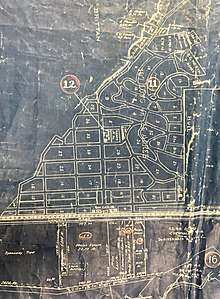
Timothy Phelps, a wealthy politician, made an early attempt to further develop the San Carlos area. He paid for significant improvements such as sewer lines and street grading, and began to promote lot sales in what he immodestly called "The Town of Phelps".
Phelps' sales were largely unsuccessful, and he eventually sold much of his land to Nicholas T. Smith's San Carlos Land Development Company. Other developers were not overly fond of Phelps' eponymous efforts, and decided to rename the town. Some maps are existent referring to the area as "Lomitas" ("little hills" in Spanish) but eventually due to historical legend, the name "San Carlos" was chosen. As noted previously, it was believed that Portolá had first seen the San Francisco Bay on November 4 from the San Carlos hills. November 4 is the feast day of St. Charles. As well, the Spanish king at the time was Carlos III, and the first ship to sail into San Francisco bay was the San Carlos.
The newly named region—not yet incorporated—received a boost with the construction of the Peninsula Railroad Corridor in 1863, and the addition, of a station at San Carlos in 1888.
Growth remained slow through the turn of the 20th century, with most residents enjoying the short 35-minute train ride to San Francisco while living in a rural setting. The Hull family operated a dairy located at the modern intersection of Hull and Laurel. Many of the other residents which were not involved in agriculture were wealthy business and professional men who worked with the railroad or in San Francisco.
Despite the efforts of the developers, growth was very slow in this period, and San Carlos ended the 19th century with fewer than one hundred houses and families.
1900–1941
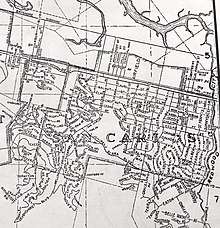
The turn of the 20th century saw the layout of the initial town streets. While "Old County Road" east of the railroad track had been in use as a stage line since at least 1850, the present-day layout west of the railroad track was constructed in the first years of 1900. Cedar, Elm, Laurel, Magnolia, Maple (renamed El Camino Real) and Walnut were put down in this time.
Growth remained slow through the first fifteen years of the new century, but in 1918 the town had grown enough to build a school at 600 Elm Street. One year previously Frederick Drake ("The Father of San Carlos") had purchased 130 acres (53 hectares) of real estate in San Carlos in foreclosure, and began marketing it. Growth came quickly, and the early 1920s saw Drake build an office at the southwest corner of Cypress (now San Carlos Ave) and El Camino Real, which is still existent, and as of May 2013 is home to an AT&T Cellular store. In the early 1920s, the cypresses along Cypress Ave. were removed, and the street widened and renamed San Carlos Ave. In 1923 the growing municipality founded a fire station, and in 1925 the founders voted to incorporate.
The Great Depression affected families in San Carlos, as it did everywhere, but growth continued, and population grew from approximately 600 at incorporation in 1925 to 5,000 in 1941.
While services such as stores increased in this period, by the beginning of World War II San Carlos was still known in the Bay Area as a rural community. Most of the land in the municipality was still used for agricultural purposes, and photographs of the time show a landscape with few houses separated by large fields.
1941–1945
War Dogs
During World War II, not long after the attack on Pearl Harbor, the American Kennel Club and a new group calling itself "Dogs for Defense" mobilized dog owners across the country to donate quality animals to the Quartermaster Corps. Dogs donated by a patriotic public to the Army saved the lives of a number of soldiers in combat.[12]
In October 1942, the US Army and “Dogs for Defense” came to San Carlos. The 178 acre site, at the top of today's Club and Crestview Drives, which was locally known as the H and H Ranch, was selected to become the US Army War Dog Reception and Training Center[13] (also known as Western Remount Area Reception and Training Center). It was established between October 15, 1942 and November 7, 1942.
The first enlisted men for the army post were temporarily housed in the San Carlos Fire Station (located on Laurel Street between San Carlos Ave. and Holly St.) from December 15 to 28, 1942. Each dog handler was given four dogs to train, and at the end of the course, the trainer selected the best one and shipped out.[13] Dogs were trained for sentry, attack, scout, and messenger roles, and later to detect mines. 1,200 dogs could be accommodated at any one time.
The first army dog platoon to go overseas in the Pacific was the 25th Quartermaster Corps War Dog Platoon, under the command of 1st Lt. Bruce D. Walker. When they left San Carlos, on May 11, 1944, none of the handlers knew what their final destination would be. They left via San Francisco aboard the Liberty ship SS John Isaacson for assignments in the Pacific Theatre.[14]
The facility closed in October 1944,[13] with approximately 4,500 dogs going through the facility during the war.
1945 to the end of the 20th century
In 1944, Dalmo Victor established the city's first large electronics plant, followed soon after by Eitel McCullough, Varian Associates (Later occupied by Tesla Motors and currently by Devil's Canyon Brewing Company), and Lenkurt Electric Company.
Establishment of these two firms was a factor in the quadrupling of San Carlos population in the decade after 1940. In 1950, when the population was 14,371, the city boasted a total of 89 industries: wholesalers, manufacturers and distributors, producing a variety of commodities from electronics to cosmetic. By 1958, the electronic industry comprised a substantial segment of the city's industrial area.
In the late 1940s when Bayshore was a two-lane road, the San Carlos Airport was moved from its former location between Brittan and San Carlos Avenues to its present site. The airport was bought by the county from Cal West Yacht Harbor in 1964 for $990,000.
Geography
San Carlos is located on the San Francisco Peninsula.
According to the United States Census Bureau, the city has a total area of 5.54 square miles (14.3 km2), of which, 5.54 square miles (14.3 km2) of it is land and 0.05% is water.
Climate
| Climate data for San Carlos, California | |||||||||||||
|---|---|---|---|---|---|---|---|---|---|---|---|---|---|
| Month | Jan | Feb | Mar | Apr | May | Jun | Jul | Aug | Sep | Oct | Nov | Dec | Year |
| Record high °F (°C) | 78 (26) |
80 (27) |
89 (32) |
97 (36) |
102 (39) |
109 (43) |
110 (43) |
105 (41) |
107 (42) |
104 (40) |
87 (31) |
77 (25) |
110 (43) |
| Average high °F (°C) | 58.5 (14.7) |
62.3 (16.8) |
65.5 (18.6) |
70.2 (21.2) |
74.4 (23.6) |
79.2 (26.2) |
82.4 (28.0) |
82.1 (27.8) |
80.2 (26.8) |
74.4 (23.6) |
65.3 (18.5) |
58.2 (14.6) |
71.1 (21.7) |
| Average low °F (°C) | 40.3 (4.6) |
43.8 (6.6) |
45.2 (7.3) |
46.5 (8.1) |
50.7 (10.4) |
54.3 (12.4) |
56.3 (13.5) |
56.5 (13.6) |
54.4 (12.4) |
50.5 (10.3) |
44.3 (6.8) |
40.1 (4.5) |
48.6 (9.2) |
| Record low °F (°C) | 16 (−9) |
25 (−4) |
29 (−2) |
33 (1) |
36 (2) |
39 (4) |
40 (4) |
43 (6) |
38 (3) |
33 (1) |
29 (−2) |
19 (−7) |
16 (−9) |
| Average precipitation inches (mm) | 4.02 (102) |
4.09 (104) |
3.13 (80) |
1.16 (29) |
0.47 (12) |
0.1 (2.5) |
0.01 (0.25) |
0.05 (1.3) |
0.16 (4.1) |
1.06 (27) |
2.37 (60) |
3.84 (98) |
20.46 (520.15) |
| Source: "The Weather Channel[15] | |||||||||||||
Demographics
| Historical population | |||
|---|---|---|---|
| Census | Pop. | %± | |
| 1930 | 1,132 | — | |
| 1940 | 3,520 | 211.0% | |
| 1950 | 14,371 | 308.3% | |
| 1960 | 21,370 | 48.7% | |
| 1970 | 26,053 | 21.9% | |
| 1980 | 24,710 | −5.2% | |
| 1990 | 26,167 | 5.9% | |
| 2000 | 27,718 | 5.9% | |
| 2010 | 28,406 | 2.5% | |
| Est. 2019 | 30,185 | [10] | 6.3% |
| U.S. Decennial Census[16] | |||
2010
The 2010 United States Census[17] reported that San Carlos had a population of 28,406. The population density was 5,126.9 people per square mile (1,979.5/km2). The racial makeup of San Carlos was 22,497 (79.2%) White, 233 (0.8%) African American, 65 (0.2%) Native American, 3,267 (11.5%) Asian, 70 (0.2%) Pacific Islander, 827 (2.9%) from other races, and 1,447 (5.1%) from two or more races. Hispanic or Latino of any race were 2,855 persons (10.1%).
The Census reported that 28,315 people (99.7% of the population) lived in households, 79 (0.3%) lived in non-institutionalized group quarters, and 12 (0%) were institutionalized.
There were 11,524 households, out of which 3,854 (33.4%) had children under the age of 18 living in them, 6,645 (57.7%) were opposite-sex married couples living together, 830 (7.2%) had a female householder with no husband present, 352 (3.1%) had a male householder with no wife present. There were 481 (4.2%) unmarried opposite-sex partnerships, and 112 (1.0%) same-sex married couples or partnerships. 2,972 households (25.8%) were made up of individuals and 1,109 (9.6%) had someone living alone who was 65 years of age or older. The average household size was 2.46. There were 7,827 families (67.9% of all households); the average family size was 2.99.
The population was spread out with 6,699 people (23.6%) under the age of 18, 1,176 people (4.1%) aged 18 to 24, 7,657 people (27.0%) aged 25 to 44, 8,827 people (31.1%) aged 45 to 64, and 4,047 people (14.2%) who were 65 years of age or older. The median age was 42.6 years. For every 100 females, there were 93.6 males. For every 100 females age 18 and over, there were 90.7 males.
There were 12,018 housing units at an average density of 2,169.1 per square mile (837.5/km2), of which 8,282 (71.9%) were owner-occupied, and 3,242 (28.1%) were occupied by renters. The homeowner vacancy rate was 1.4%; the rental vacancy rate was 5.3%. 21,635 people (76.2% of the population) lived in owner-occupied housing units and 6,680 people (23.5%) lived in rental housing units.
|
2000
As of the census[19] of 2000, there were 27,238 people, 11,455 households, and 7,606 families residing in the city. The population density was 4,685.1 people per square mile (1,807.8/km2). There were 11,691 housing units at an average density of 1,976.1 per square mile (762.5/km2).
There were 11,455 households out of which 29.7% had children under the age of 18 living with them, 56.5% were married couples living together, 7.2% had a female householder with no husband present, and 33.6% were non-families. 25.7% of all households were made up of individuals and 9.6% had someone living alone who was 65 years of age or older. The average household size was 2.40 and the average family size was 2.93.
In the city, the population was spread out with 22.1% under the age of 18, 4.3% from 18 to 24, 33.0% from 25 to 44, 26.2% from 45 to 64, and 14.3% who were 65 years of age or older. The median age was 40 years. For every 100 females, there were 92.6 males. For every 100 females age 18 and over, there were 88.6 males.
According to a 2007 estimate, the median income for a household in the city was $99,110, and the median income for a family was $137,325.[20] Males had a median income of $70,554 versus $51,760 for females. The per capita income for the city was $46,628. 2.7% of the population and 1.4% of families were below the poverty line. Out of the total people living in poverty, 2.3% were under the age of 18 and 3.7% were 65 or older.
Economy
Companies based in San Carlos include Check Point, Kelly-Moore Paints, MarkLogic, Helix, and Natera.
Top employers
According to the City's 2017 Comprehensive Annual Financial Report,[21] the top employers in the city are:
| # | Employer | # of Employees |
|---|---|---|
| 1 | Palo Alto Medical Foundation | 500 |
| 2 | Natera | 405 |
| 3 | L-3 Communications | 389 |
| 4 | Pacific Gas and Electric | 331 |
| 5 | Recology | 240 |
| 6 | Novartis | 230 |
| 7 | The Home Depot | 221 |
| 8 | Check Point | 208 |
| 9 | Kelly-Moore Paints | 193 |
| 10 | Delta Star | 188 |
L-3 Communications manufactured gas-filled and vacuum tubes used among others in radar system and TV-emitters at their San Carlos plant. In 2016, the company announced they would be moving their operations to South California and Pennsylvania.[22]
Arts and culture
The San Carlos History Museum is dedicated to the display of the history of the town from early Native American history to the space age. This museum is open every Saturday from 1:00 PM to 4:00 PM. The Hiller Aviation Museum, a museum specializing in helicopter and aviation history, offers interactive exhibits and more than forty aircraft including a replica of the first aircraft to fly, a spy drone with a 200-foot wingspan, and the nose section of a Boeing 747.
San Carlos was also once home of the Circle Star Theater where performers such as Big Brother & the Holding Company, Richard Marx and Richard Pryor performed. It was torn down and replaced with office buildings.
Every May, the town hosts the "Hometown Days" carnival in Burton Park, the city's largest park. In October, the Chamber of Commerce hosts the San Carlos "Art & Wine Faire". October 2015 marked the 25th year it has been held. Sunday mornings during the summer Laurel street is home to a weekly farmer's market. San Carlos is home to a sculpture titled "Balancing Act" by artist James Moore, in front of Frank D. Harrington park on Laurel Street, which is often decorated for various holidays and local events.
The city is served by the San Carlos Public Library of the San Mateo County Libraries, a member of the Peninsula Library System.
Government
Municipal government
The current mayor of San Carlos is Ron Collins. The other four City Council member are Mark Olbert, Laura Palmer-Lohan, Sara McDowell, and Adam Rak.[4]
Brad Lewis, a producer of films including Ratatouille, served as mayor in 2008.
According to the California Secretary of State, as of February 10, 2019, San Carlos has 19,706 registered voters. Of those, 9,590 (48.7%) are registered Democrats, 3,657 (18.6%) are registered Republicans, and 5,699 (28.9%) have declined to state a political party.[23]
State and federal representation
In the California State Legislature, San Carlos is in the 13th Senate District, represented by Democrat Jerry Hill, and in the 22nd Assembly District, represented by Democrat Kevin Mullin.[6]
In the United States House of Representatives, San Carlos is in California's 14th congressional district, represented by Democrat Jackie Speier.[24]
Education
Public schools
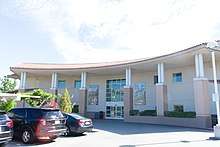
The public schools in San Carlos are run by the San Carlos School District, although the school district boundaries do not cover the entire city of San Carlos. There are several elementary schools (K-4) and a few middle schools (5-8), (Carlmont High School) nearest public high school in the neighboring city of Belmont since the 1982 closure of San Carlos High School. In 1996, Vice President Al Gore came to speak at Arundel Elementary School in regards to Net Day '96, and former President Bill Clinton came to Charter Learning Center in 1997.
Middle schools
- Central Middle School[31]
- Tierra Linda Middle School
- Charter Learning Center (Kindergarten through 8th grade)
High schools
Up until 1982 San Carlos had its own public high school, San Carlos High School. It was closed due to a decline in student enrollment from an overall aging of San Carlos residents, with the students of San Carlos middle schools divided up among the nearby Carlmont High School in Belmont and Sequoia High School in Redwood City. The playing fields were kept and converted into Highlands Park, which now hosts many local youth sporting groups, while the school was replaced with new housing. By the late 1990s and early first decade of the 21st century, city demographics changed again to a new generation of younger families with children, with the concurrent growth in student populations a new challenge for local schools. In December 2014, the SUHSD decided they wanted to develop a 400 student high school on Old County Road. They made the determination that there was no need to build any athletic facilities, instead opting to take over the adjacent Laureola Park despite community protest.[32] The local community is fighting this proposed school.[33]
Private schools
- St. Charles School[34]
Non-Public schools
- Arbor Bay School[35]
Infrastructure
Bus service
Transportation options include membership in the SamTrans (San Mateo County Transit) bus system and a Caltrain station. The administrative headquarters of both agencies are located at 1250 San Carlos Avenue. In 2003, the city began experimenting with a free shuttle bus service named S.C.O.O.T. to help with transportation difficulties for those living in the hills of the town, and especially to make up for a lack of school buses. However, voters rejected a parcel tax that placed 100% of the financial burden on property owners and the S.C.O.O.T. program was dismantled on June 17, 2005.
Airport
San Carlos Airport is located in San Carlos.
Notable people
- Luís Antonio Argüello, first governor of Alta California
- Kathryn Bigelow, film producer, director, first woman to win the Academy Award for Best Director[36]
- Hunter Bishop (born 1998), baseball player
- Barry Bonds, former MLB player[37]
- Bobby Bonds, former MLB player[38]
- Sorcha Boru, pottery maker[39]
- Steve Capps, former Apple Fellow[40]
- Keith Comstock, former MLB player and professional baseball coach.[41]
- Dana Carvey, actor[42]
- Jim Davenport, former MLB player/coach/manager[43][44]
- Daniel Descalso, MLB player[45]
- Jennifer Granholm, former governor of Michigan, political commentator on CNN, graduated from San Carlos High School[46]
- Randy Gomez, former Major League Baseball catcher.[44]
- Rachelle Leah, model and television personality[39]
- Brad Lewis, producer of Pixar film Ratatouille and former city mayor[47]
- Kevin McCarthy, director of American Television game show, Jeopardy!
- Paul McClellan, American Major League Baseball player for the San Francisco Giants
- Mike McCurry, former United States press secretary
- Timothy Guy Phelps, president of Southern Pacific Railroad[48]
- Greg Proops, actor and stand-up comedian[49]
- Dick Stuart, former MLB player (born in San Francisco, raised in San Carlos)[50][51]
- Tom Tennant, baseball player[52]
- Mark Ulriksen, painter and magazine illustrator[53]
- Rex J. Walheim, NASA astronaut, flying on three space shuttle missions, STS-110, STS-122 and the final space shuttle mission, STS-135[54]
- Bob Wasserman, former San Carlos police chief (1969–1972) and Mayor of Fremont, California (2004-2011)[55]
- Chris Willsher, Major League Baseball player[56]
Sister cities
Former
See also
References
- "2010 Census U.S. Gazetteer Files – Places – California". United States Census Bureau.
- "California Cities by Incorporation Date". California Association of Local Agency Formation Commissions. Archived from the original (Word) on November 3, 2014. Retrieved August 25, 2014.
- "City Manager". City of San Carlos. Archived from the original on February 7, 2015. Retrieved February 6, 2015.
- "City Council". City of San Carlos. Retrieved January 20, 2019.
- "City Treasurer". City of San Carlos. Archived from the original on February 7, 2015. Retrieved February 6, 2015.
- "Statewide Database". UC Regents. Archived from the original on February 1, 2015. Retrieved December 16, 2014.
- "2019 U.S. Gazetteer Files". United States Census Bureau. Retrieved July 1, 2020.
- "San Carlos". Geographic Names Information System. United States Geological Survey.
- "San Carlos (city) QuickFacts". United States Census Bureau. Archived from the original on February 28, 2016. Retrieved April 14, 2015.
- "Population and Housing Unit Estimates". United States Census Bureau. May 24, 2020. Retrieved May 27, 2020.
- http://dictionary.sensagent.com/lamchin/en-en/
- U.S. Army Quartermaster Museum, Fort Lee, Virginia "Archived copy". Archived from the original on January 20, 2013. Retrieved January 20, 2013.CS1 maint: archived copy as title (link)
- Images of America – San Carlos by Nicholas A. Veronico & Betty S. Veronico, Arcadia Publishing
- Lemish, Michael G. War Dogs: A History of Loyalty and Heroism. Brassey’s Inc.
- "Average Climate for San Carlos California". The Weather Channel. January 2018. Retrieved January 13, 2018.
- "Census of Population and Housing". Census.gov. Retrieved June 4, 2015.
- "2010 Census Interactive Population Search: CA - San Carlos city". U.S. Census Bureau. Archived from the original on July 15, 2014. Retrieved July 12, 2014.
- "Demographic Profile Bay Area Census".
- "U.S. Census website". United States Census Bureau. Retrieved January 31, 2008.
- American FactFinder. Factfinder.census.gov. Retrieved on July 21, 2013.
- "City of San Carlos CAFR". cityofsancarlos.org. Archived from the original on February 4, 2015. Retrieved August 25, 2018.
- "L-3 Communications to Consolidate San Carlos Operations". May 17, 2016. Retrieved May 29, 2019.
- "CA Secretary of State – Report of Registration – February 10, 2019" (PDF). ca.gov. Retrieved March 12, 2019.
- "California's 14th Congressional District - Representatives & District Map". Civic Impulse, LLC. Retrieved March 12, 2013.
- Arundel
- Brittan Acres
- Heather
- White Oaks
- Arroyo
- Mariposa
- Central Middle School
- http://www.smdailyjournal.com/articles/lnews/2014-12-10/plans-proceeding-for-two-high-schools-traffic-from-one-magnet-a-concern-for-some-san-carlos-neighbors-other-planned-for-menlo-park/1776425134761.html
- "Coming Soon". www.savelaureolapark.org. Retrieved March 26, 2018.
- St. Charles School
- Arbor Bay School
- "Profile: Kathryn Bigelow". March 8, 2010. Retrieved March 26, 2018 – via news.bbc.co.uk.
- "Barry Bonds - Society for American Baseball Research". sabr.org. Retrieved March 26, 2018.
- "Barry Bonds' Childhood Home on Market". nbcbayarea.com. Retrieved March 26, 2018.
- Nicholas A. Veronico; Betty S. Veronico (2007). San Carlos. Arcadia Publishing. p. 92. ISBN 978-0-7385-4793-0. Retrieved March 26, 2018.
- "AllPolitics - TIME This Week: Confession Of A Microsoft Converter - Mar. 17, 1997". edition.cnn.com. Retrieved March 26, 2018.
- "San Mateo County Historical Association". San Mateo County History Museum. Retrieved September 25, 2019.
- "Dana Carvey's favorite role: fatherhood". sfgate.com. April 30, 2010. Retrieved March 26, 2018.
- "Jim Davenport, former Giants third baseman, dies". mercurynews.com. February 19, 2016. Retrieved March 26, 2018.
- "2014 Giants Media Guide - San Francisco Giants" (PDF). San Francisco Giants Media Guide. Retrieved September 25, 2019.
- "St. Louis Cardinals second baseman grew up an Oakland A's fan". mercurynews.com. October 13, 2012. Retrieved March 26, 2018.
- Goldstein, Amy (May 20, 2009). "Governor Granholm's Rise to Politics". Retrieved March 26, 2018 – via www.washingtonpost.com.
- "San Carlos mayor relishes Oscar win for 'Ratatouille'". eastbaytimes.com. February 26, 2008. Retrieved March 26, 2018.
- "Phelps, Timothy Guy - San Carlos was nearly named Phelpsville". historysmc.pastperfectonline.com. Retrieved March 26, 2018.
- "PASSED/FAILED: Greg Proops". independent.co.uk. July 17, 1997. Retrieved March 26, 2018.
- Litsky, Frank (December 19, 2002). "Dick Stuart: Pirates' Slugger 'Dr. Strangeglove'". The Pittsburgh Post-Gazette. Retrieved July 16, 2018.
- United Press International (May 13, 1959). "Giants Learn Meaning of Too Little, Too Late". The Madera Tribune. Retrieved July 6, 2018.
- "Tom Tennant - Society for American Baseball Research". sabr.org. Retrieved March 26, 2018.
- "interview to mark ulriksen". web.tiscali.it. Retrieved September 25, 2019.
- Whiting, Melanie (February 18, 2016). "Rex J. Walheim (Colonel, U.S. Air Force, Ret.) NASA Astronaut". nasa.gov. Retrieved March 26, 2018.
- "Fremont mayor Bob Wasserman dead at 77". East Bay Times. December 29, 2011. Retrieved August 31, 2018.
- Beitiks, Edvins; Staff, Of the Examiner (February 15, 1995). "One strike, he's in: Local appraiser signs with Rangers". SFGate. Retrieved September 25, 2019.
- "Our Sister Cities". San Carlos Sister City Association. January 28, 2013. Retrieved July 16, 2018.
Further reading
- San Carlos Stories: An Oral History for the City of Good Living, by Linda Wickert Garvey, Copyright 2000 The City of San Carlos, California.
- Images of America: San Carlos by Nicholas A. Veronico and Betty S. Veronico. Arcadia Publishing, September 24, 2007. ISBN 978-0738547930.

